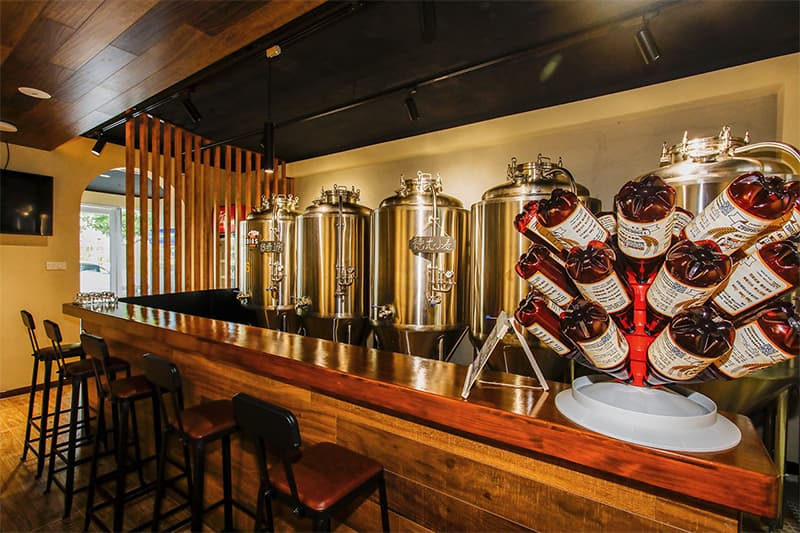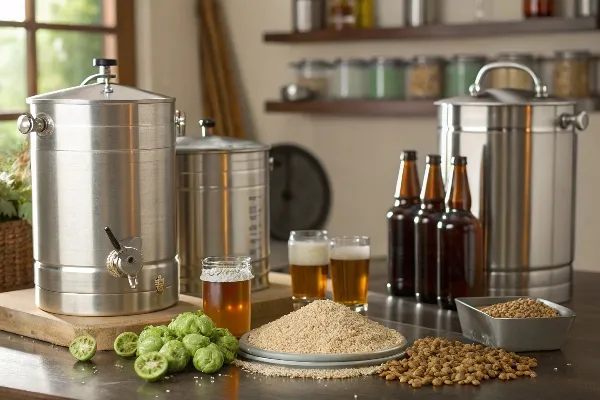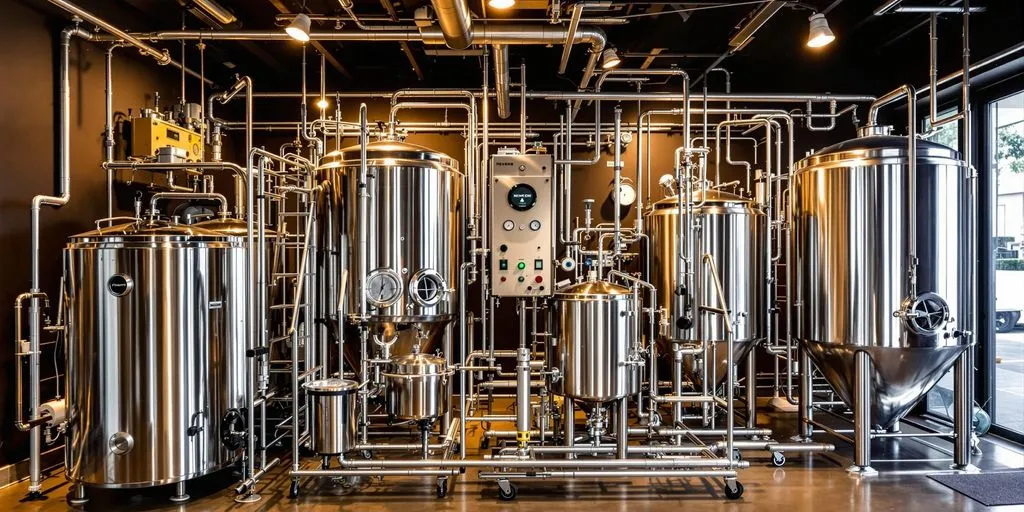I once felt unsure whether launching my own craft brewery was too big a dream. I worried about hidden costs, licensing, and complex equipment. Those doubts held me back for years.
Starting your own craft brewery involves careful planning, clear budgeting, and a passion for experimentation. You need to handle permits, buy the right equipment, and create flavorful beers.

Craft beer is more than a drink—it’s a creative journey. I found that once I understood the steps involved, my doubts gave way to excitement. Let’s explore how you can start your own brewery, from overcoming initial fears to choosing gear and finalizing your first batches.
Is Brewing Beer Difficult?
I used to ask myself if brewing was too technical or time-consuming. I imagined complicated recipes and advanced chemistry that would overwhelm my schedule.
Brew your first batch by following clear instructions and prioritizing sanitization. Mistakes happen, but simple recipes and reliable tools make brewing less daunting.

Understanding Brewing Challenges
When I began, I realized that brewing involves multiple stages: mashing, boiling, fermentation, and conditioning. At first glance, each step looked like a science project. Yet once I followed a step-by-step guide, everything fell into place. Below are the main reasons people find brewing challenging, along with how to handle them:
1. Recipe Complexity
- Problem: Too many ingredients lead to confusion.
- Solution: Start with a simple ale or stout recipe. Fewer malts and hops reduce confusion, allowing you to learn fundamentals.
2. Temperature Control
- Problem: Yeast health depends on stable temperatures.
- Solution: Use a temperature strip or a controlled fermentation chamber. Aim for the yeast’s recommended range, usually around 65–72°F (18–22°C).
3. Sanitization
- Problem: Contamination can spoil an entire batch.
- Solution: Always sanitize all equipment. I rely on no-rinse sanitizers for convenience.
| Brewing Stage | Main Goal | Key Challenge |
|---|---|---|
| Mashing | Convert starches | Maintaining mash temperature |
| Boiling | Sterilize wort | Timing hop additions |
| Fermentation | Produce alcohol | Keeping yeast healthy |
| Conditioning | Refine flavors | Managing oxygen exposure |
A big part of brewing is learning by doing. Even if you make mistakes, you gain experience and insight that improves your next batch. As you grow, you can try advanced techniques like all-grain brewing, water chemistry adjustments, or barrel aging. Over time, I found that brewing isn’t about perfection; it’s about turning raw ingredients into a satisfying drink while having fun.
How Long Does It Take for a Brewery to Make Beer?
When I first pictured running a craft brewery, I worried that production schedules would be impossible to manage. I needed a timeline to guide me.
Breweries typically need two to six weeks to produce most ales, with lagers taking longer. Complex, high-gravity beers can require months of aging for full flavor.
Craft Brewery Production Timelines
In a commercial setting, time is money. Yet rushing beer risks quality. Most craft breweries balance a production pipeline of core beers with smaller batches of seasonal or experimental brews. Here’s how the timeline might break down:
1. Wort Production (Brew Day)
- Usually takes 6–8 hours. The brewer mills grains, mashes them, sparges (rinses), boils, and adds hops at scheduled intervals. Cooling the wort rapidly to yeast-friendly temperatures concludes the brew day.
2. Primary Fermentation
- For ales, primary fermentation often lasts one to two weeks at around 65–72°F (18–22°C). The yeast converts sugars into alcohol and carbon dioxide. Brewers watch for stable gravity readings to ensure the process is complete.
3. Secondary Fermentation or Conditioning
- Some breweries skip a secondary vessel, while others use it to clarify beer or add flavors like fruit. This step can last from a few days to several weeks.
4. Packaging and Carbonation
- Kegs, bottles, or cans get filled. If natural carbonation is desired, extra time for conditioning might be needed. Force-carbonation with CO2 in kegs is faster, often just a couple of days.
Below is a simplified timeline for a standard ale in a craft brewery:
| Stage | Duration | Key Activities |
|---|---|---|
| Brew Day | 1 day | Mash, boil, hop additions, wort cooling |
| Primary Fermentation | 7–14 days | Yeast converts sugars, brewer monitors gravity |
| Secondary/Conditioning | 3–14 days | Clarification, flavor additions (optional) |
| Packaging & Carbonation | 2–7 days | Kegging, bottling, forced or natural carbonation |
Lagers often extend the timeline by several weeks for cold conditioning. Certain high-gravity or barrel-aged beers may need months, sometimes over a year, for the flavors to mature. Setting realistic schedules and planning tank usage ensures you always have beer ready to serve without rushing crucial steps. Consistency is everything. If a beer needs more time, it’s best not to hurry. Customers often notice rushed flavors or incomplete conditioning. Balancing speed with quality defines a craft brewery’s reputation.
What Are the Three Types of Brewing Equipment?
Imagining the shiny tanks and specialized gear often sparks excitement. But sorting through fermenters, mash tuns, and bright tanks can be confusing.
Brewing equipment typically falls into three categories: the brewhouse (mash tun, brew kettle, hot liquor tank), fermentation vessels, and brite or serving tanks. Each set serves a unique step in the brewing process.

Core Brewery Equipment Breakdown
When building a craft brewery, investing in the right equipment is a major decision. Capacity, material quality, and automation level all matter. Below is a structured look at the three main categories of brewing gear:
1. The Brewhouse
This is where raw grains become wort (unfermented beer). A standard brewhouse includes:
- Mash Tun: Holds grains and hot water, converting starches into fermentable sugars.
- Lauter Tun or Mash/Lauter Combo: Separates wort from spent grains. In smaller breweries, the mash tun often doubles as a lauter tun.
- Brew Kettle/Boil Kettle: Boils the wort with hops, driving off unwanted compounds.
- Hot Liquor Tank: Stores hot water used for mashing and sparging.
2. Fermentation Vessels
Here, yeast transforms wort into beer:
- Fermenters: Conical tanks or cylindrical vessels equipped with temperature control.
- Unitanks: Can function as both fermenter and brite tank, reducing transfers.
- Secondary Fermenters: Optional vessels for additional conditioning or flavor infusions.
| Equipment Type | Purpose | Key Considerations |
|---|---|---|
| Mash Tun | Convert starch to sugar | Insulated design, temperature control |
| Boil Kettle | Boil wort, add hops, remove proteins | Volume capacity, steam vs. direct fire |
| Fermenter | House yeast, control fermentation | Temperature jackets, conical bottom |
| Brite Tank | Clarify, carbonate, store beer | Pressure-rated, final step for serving |
3. Brite or Serving Tanks
After fermentation, beer moves to these tanks for clarification and carbonation. CO2 is added under pressure to achieve desired fizz levels. Some breweries serve directly from brite tanks into kegs or canning lines.
Having the right combination of these three categories lets you manage workflow efficiently. I found that each upgrade—like a better temperature-control system or an automated mash schedule—improves consistency and reduces labor. Choosing reputable manufacturers ensures equipment longevity. While upfront costs can be high, reliable gear helps you maintain the quality that defines a successful craft brewery.
Is Craft Beer Higher Quality?
I sometimes hear that craft beer delivers fresher, bolder tastes than mass-market brands. But I wondered if that automatically means higher quality across the board.
Craft beer often employs better ingredients, specialized techniques, and smaller batch sizes for richer flavors. While ‘quality’ is subjective, craft brewers typically focus on taste and freshness, giving them an edge over mass-produced beer.

Evaluating Craft Beer Quality
Quality in beer can mean different things to different drinkers. Some associate it with intense flavors, while others want consistent, clean finishes. Craft breweries usually emphasize unique recipes, local ingredients, and hands-on care. This smaller scale makes it easier to preserve freshness.
1. Ingredient Selection
- Many craft brewers choose premium malts, specialty grains, and aromatic hops.
- Experimentation with fruit, spices, or barrel aging yields bold, complex profiles.
2. Technique and Innovation
- Batch sizes are smaller, so brewers can fine-tune flavor adjustments.
- Temperature control, yeast pitching rates, and water chemistry get close attention.
3. Freshness and Distribution
- Craft breweries often distribute locally, reducing travel time.
- Seasonal offerings align with ingredient availability, capitalizing on peak freshness.
I recall trying my first “craft” IPA. It tasted more vibrant than any mass-produced beer I had sampled. The bright citrus notes and crisp bitterness felt more alive. However, ‘quality’ can still vary among craft brewers. Some are meticulous about sanitization and packaging, while others risk contamination or inconsistencies. Demand can outstrip capacity, leading to rushed batches. Therefore, not every craft beer stands above the mainstream. But overall, the craft beer movement focuses on distinctive flavors and small-scale refinement, which many interpret as higher quality.
Conclusion
Launching a craft brewery takes commitment, careful planning, and the right equipment. Though the journey can be challenging, the satisfaction of pouring your own distinctive beer makes every step worthwhile.
